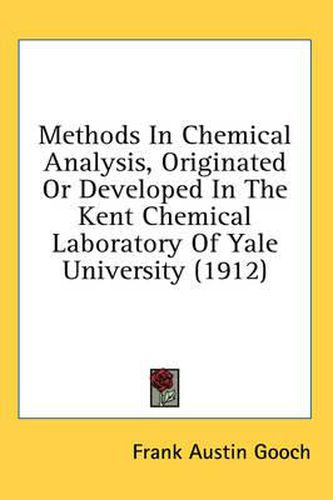Methods in Chemical Analysis, Originated or Developed in the Kent Chemical Laboratory of Yale University (1912)
Frank Austin Gooch

Methods in Chemical Analysis, Originated or Developed in the Kent Chemical Laboratory of Yale University (1912)
Frank Austin Gooch
METHODS IN CHEMICAL ANALYSIS ORIGINATED OR DEVELOPED IN THE KENT CHEMICAL LABORATORY OF YALE UNIVERSITY COMPILED - 1912 – PREFATORY NOTE THE - object of this volume is to present concisely the principal results reached by workers in the Kent Chemical Laboratory of Yale University in the investigation and development of methods in chemical analysis. In the account of processes, modified or original, only proved procedure and immediately related experimental data are, as a rule, given. For further details in respect to the elaboration of processes, the discussion of difficulties, and the experimental illustration of the effects of varying the prescribed procedure, references are given to the original sources from which this summary has been compiled. To his colleagues, Professors Philip E. Browning, R. G. Van Name, and W. A. Drushel, the compiler is much indebted for valuable criticism of the proof sheets. CONTENTS. CHAPTER I. APPLIANCES AND GENERAL PROCEDURE. Mechanical Processes. - The determination of products gaseous at ordinary temperatures by loss of weight, I. The distillation and condensation of volatile products, 3. The distillation and absorption of volatile products, 4 apparatus with ground joints, 4 apparatus with sealed joints, 5. The removal of volatile products from material to be reserved for treatment. The prevention of mechanical loss from solution in reactions evolving gaseous products, 6. The transfer of liquids and gases under pressure, 7. A convenient form of rotary shaker, g. The purification of precipitates by solution and reprecipitation, 10. Electrolytic processes. - The rotating cathode, I I. The filtering crucible, 13 electrolysis and subsequent filtration, 13electrolysis with filtration, 16 electrolysis wit h continuous filtration, I 7. The fixation of chlorine on the silver anode, 20 hydrochloric acid, silver anode, and platinum cathode, 20 sodium chloride, silver anode, and mercury cathode, 22. Iodometric processes. - The standardization of iodine solutions by the action of metallic silver, 27. Arsenic trioxide as an iodometric standard, 29. The starch indicator for free iodine, 29. Standard tartar emetic, 38. Processes of oxidation. - Arsenic trioxide as a standard, 41 standardization without iodine, 41 standardization with the aid of iodine, 42. The gravimetric standardization of permanganate, 42. The loss of oxygen in oxidation by permanganate, 42 concentration of acid, 42 hydrochloric acid with ferrous salts, 48 hydrochloric acid with oxalic acid, 50 effect of other chlorides, 52. Acidimetry and Alkalimetry. - The use of succinic acid as a standard, 54. Organic acids and acid anhydrides as standards, 56. The use of the iodideiodate mixture and the estimation of iodine evolved, 59 determination of free acids, 59 determination of alkali hydroxides and carbonates, 60 determination of acids liberated in hydrolysis, 61. The use of the bromide-bromate mixture and estimation of the bromine evolved, 70. Reaction of iodine with alkali hydroxides, 70. CHAPTER 11. THE ALKALI METALS. Sodium. - The detection of sodium, 74 the estimation of sodium as the pyrosulphate, 79. Potassium. - The spectroscopic detection and determination of potassium, 80 detection of potassium, 80 determination of potas sium, 83. The separation and determination of potassium as the perchlorate, v vi CONTENTS 88. The estimation of potassium as the pyrosulphate, 92…
This item is not currently in-stock. It can be ordered online and is expected to ship in approx 2 weeks
Our stock data is updated periodically, and availability may change throughout the day for in-demand items. Please call the relevant shop for the most current stock information. Prices are subject to change without notice.
Sign in or become a Readings Member to add this title to a wishlist.


